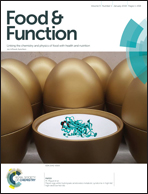Ginger fermented with Schizosaccharomyces pombe alleviates memory impairment via protecting hippocampal neuronal cells in amyloid beta1–42 plaque injected mice
Abstract
Ginger, which has been widely used for dietary condiment, has been reported to improve memory dysfunction in an animal model of Alzheimer's disease (AD). Recently, a few trials have been carried out to enhance the effects of ginger by improving the bioavailability of its relevant components via fermentation. Some reports have suggested that the fermented ginger has the ability to affect the AD in vitro systems; however, its anti-amnesic effects on an in vivo model still remain to be investigated. In the present study, we aimed to investigate the neuroprotective effects of ginger fermented with Schizosaccharomyces pombe (FG) in the in vivo models of AD. The neuroprotective effects were investigated by employing behavioral, western blotting, and immunohistochemical assays. The administration of FG improved recognition memory, impaired by scopolamine injection, than that of non-fermented ginger. In addition, FG ameliorated memory impairment in amyloid beta1–42 (Aβ1–42) plaque-injected mice via protecting neuronal cells in the CA3 area of the mouse hippocampus. Moreover, FG reinstated the pre- and postsynaptic protein levels decreased by Aβ1–42 plaque-toxicity. Overall, these data suggest that FG attenuates memory impairment in Aβ1–42 plaque-induced AD mice through inhibition of neuronal cell loss and synaptic disruption.



 Please wait while we load your content...
Please wait while we load your content...